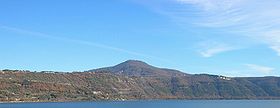- Alban Hills
-
Alban Hills Colli Albani 
Monte Cavo (the Alban Mount) and the Alban LakeElevation 950 m (3,117 ft) Prominence Monte Cavo Location Location East of Rome, Italy Range Roman Comagmatic Province Coordinates 41°43′48″N 12°42′0″E / 41.73°N 12.7°ECoordinates: 41°43′48″N 12°42′0″E / 41.73°N 12.7°E Geology Type Stratovolcano Last eruption 5,000 BC The Alban Hills (Italian Colli Albani) are the site of a quiescent volcanic complex in Italy, located 20 km (12 mi) southeast of Rome and about 24 kilometres (15 mi) north of Anzio.
The dominant peak (but not the highest) is Monte Cavo. There are two small calderas which contain lakes, Lago Albano and Lake Nemi. The rock of the hills is called Peperino (lapis albanus) a particular Tuff, a combination of ash and small rocks that is useful for construction, and provides a mineral-rich substrate for grape vines.
Contents
History
The area was inhabited by the Latini during the 5th to 3rd centuries BC. The ancient Romans called them Albanus Mons. On the summit was the sanctuary of Jupiter Latiaris, in which the consuls celebrated the Feriae Latinae, and several generals celebrated victories here when they were not accorded regular triumphs in Rome. The temple has not survived, but the Via Triumphalis leading up to it may still be seen.
The hills, especially around the shores of the lakes, have been popular since prehistoric times. From the 9th to 7th century BC there were numerous villages (see the legendary Alba Longa and Tusculum). In Roman times these villages were inhabited as a way to escape the heat and crowds of Rome, and there are many villas and country houses.
Towns and cities
Main article: Castelli RomaniThe towns and villages in the Alban Hills are known as the Castelli Romani.
Volcanic activity
Examination of deposits have dated the two most recent eruptions to around 37,000 and 41,000 years ago. The area exhibits small localised earthquake swarms, bradyseism, and release of carbon dioxide and hydrogen sulphide into the atmosphere. The uplift and earthquake swarms have been interpreted as caused by a slowly growing spherical magma chamber 5-6 kilometres below the surface; some think that it may erupt again; if so, there is risk to Rome, which is only 25 to 30 km away.
There is documentary evidence of an eruption in 114 BC, but the absence of holocene geological deposits has largely discredited it as a volcanic event and instead the account is considered to be a description of a forest fire.
The volcano emits large amounts of carbon dioxide. This can potentially reach lethal concentrations if it accumulates in depressions in the ground in the absence of wind. The asphyxiation of 29 cows in September 1999 prompted a detailed survey, which found that concentration of the gas at 1.5 m above the ground in a residential area on the northwestern flank sometimes exceeded the occupational health threshold of 0.5%. Eight sheep were killed in a similar incident in October 2001.
People
Writers and artists who have produced work about this area include:
- Clara Louisa Wells in The Alban Hills ed. 1878
- Charles Coleman painter
- Charles H. Poingdestre painter
- Edward Lear painter and lithographer
- Ellis Cornelia Knight, writer and painter in "Description of Latium or La Campagna di Roma"
- George Gordon Byron in "Childe Harold's Pilgrimage"
- Georgina E. Troutbeck - Rambles in Rome - London - ed. Mills & Bonn - 1914
- James Duffield Harding in "Tourist in Italy"
- Johann Wolfgang von Goethe in "Italian Journey"
- John Henry Henshall watercolor painter
- Richard Colt Hoare in "A classical tour through Italy and Sicily"
- Richard Voss
- Thomas Ashby, archaeologist, wrote "The Roman Campagna in Classic Time"
- William Brockedon painter and illustrator of guide-book
- William Leighton Leitch watercolor painter in Lanuvio
- John Singer Sargent, painter in Villa Torlonia - Frascati
- Gavin Hamilton, artist and antiquarian, painter and archaeologist, in Genzano and Lanuvio (18th century)
- Stendhal, writer, in Albano Laziale, Chroniques italiennes (1836–1839):L'Abbesse de Castro
See also
References
External links
 Lazio
LazioProvinces Lakes Lake Albano • Lake Bolsena • Lake Bracciano • Lago di Canterno • Lago di Caprolace • Lago di Fondi • Lago di Giulianello • Lake Martignano • Lake Mezzano • Lago dei Monaci • Lake Nemi • Lago di Posta Fibreno • Lago di Rascino • Lago di Sabaudia • Lago del Salto • Lago del Turano • Lake VicoMountains Seven hills of Rome • Alban Hills • Aurunci Mountains • Monti Ausoni • Monte Cavo • Cimini Hills • Monti Ernici • Monte Gorzano • Monti della Laga • Monti Lepini • Monti della Meta • Monte Petrella • Monti Prenestini • Monti Sabatini • Monte Soratte • Monte Terminillo • Monti della Tolfa • Monti Volsini • Monte Cassino · Monte Abate · Monte Altino · Monte Appiolo · Maschio dell'Ariano · Maschio di Lariano · Monte Artemisio · Monte Autore · Monte Carbonaro · Monte Cefalo · Cima del Redentore (monti Aurunci) · Circeo · Monte Crispi · Monte Dragone · Monte Faggeto · Monte Fammera · Mont Fogliano · Monte Fusco · Monte Guadagnolo · Monte Lauro in Gaeta · Monte Lauzo · Le Rave Fosche · Monte Livata · Mainarde · Maschio delle Faete · Meta (monte) · Monna · Monte Caira · Monte Cervello · Monte Revole · Monte Sorgenze · Monte Trina · Monte Val de' Varri - Monte Faito - Monte San Nicola · Monte di Cambio · Monte le Pezze · Parco regionale urbano Monte Orlando · Monte Orso · Monte Pizzuto · Monte RuazzoGeographic
areasPolitics and
governmentAncient Lazio Etruscans • Latium • Latium adiectum • Latial culture • Latins (Italic tribe) • Sabines • Volsci • AequiCategories:- Geography of Roman Italy
- Geographical, historical and cultural regions of Italy
- Castelli Romani
- Mountains of Lazio
- Volcanoes of Italy
Wikimedia Foundation. 2010.


